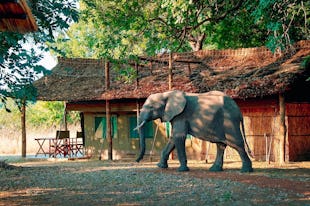
Annie’s Spectacular South Luangwa Safari
The stuff of your safari dreams



The Lower Zambezi National Park is one of our favorite destinations in Zambia. The vast reserve makes up 4500 square kilometers of Zambezi escarpment wilderness. The huge densities of wildlife tend to stick near the river, and game drives (and canoe safaris) into the park often encounter large herds of elephant, buffalo and zebra. The riverfront is also ideal leopard habitat and it's not uncommon to see one of these rare predators lazing in a tree beside the river. Travelers can self-drive through the park, or choose to stay at one of the top lodges that offer the full Lower Zambezi experience. A canoe safari along the river is also a must!
Start with a recommended trip or create one from scratch
As you might have guessed, the Lower Zambezi National Park and its myriad activities are centred around the mighty river running through it. Droves of animals travel to the river, including herds of zebra, elephant and buffalo - and you might even see them grazing on the tiny isles in the middle of the water. Idle down the river on a canoe, eyeing hippo, crocodile and a flurry of birdlife, or explore by boat followed by sundowners on the riverbank. There is abundant tiger fish in the Zambezi if you fancy a few hours of angling too. For a close-to-nature experience, leave at dawn on foot to examine fresh tracks and clues from the night’s activities. All lodges conduct a morning or afternoon game drive, but a night drive offers a different cast of wildlife, where bushbabies ogle you from the trees, shy civets and servals slink past, and you could watch lion and leopard on the hunt.
Jan
Feb
Mar
Apr
May
Jun
Jul
Aug
Sep
Oct
Nov
Dec
Wet Season
Temperatures are hot but comfortable, humidity varies throughout the month and there is a 1 in 2 chance of rain, although it usually falls at night.
Wildlife has spread out during this time of plenty, making game viewing a little more challenging.
There are many young animals around, providing high excitement amongst the predators.
Foliage is dense, green and in bloom drawing in droves of colourful butterflies.
Birding is at its peak with migrant species present and in breeding plumage.
Few camps are open over the wet season period.
Wet Season
Temperatures are hot but comfortable, humidity is unpredictable and rain falls regularly but usually at night.
Wildlife numbers have dropped, animals are spread over a larger area, enjoying a time of plenty.
The recent birthing season has left plenty of young animals for the predators to chase.
Foliage is dense, green and in bloom drawing in droves of colourful butterflies.
Birding is at its peak with migrant species present and in breeding plumage.
Few camps are open over the wet season period.
Wet Season
Temperatures are hot but comfortable, humidity has dropped and rain is falling only a couple of afternoons a week.
Wildlife has spread out during this time of plenty, making game viewing a little more challenging.
The birthing season is now over, although the large number of young antelope causes a stir amongst the predators.
Foliage is dense, green and in bloom drawing in droves of colourful butterflies.
High quality birding is still to be enjoyed with the foreign migrants still present.
Few camps are open over the wet season period.
Wet Season
Temperatures are high but comfortable, with little to no humidity, cloudy skies and rain is still a possibility.
The wet season is coming to an end, with wildlife still spread out and enjoying the numerous water sources.
The vegetation is lush and green with wildlife in its peak condition.
Birds migrate during this month, leaving the dry season behind them.
Few camps are open over the wet season period.
Dry Season
Day temperatures begin to cool with the onset of the dry season, rain is unlikely.
The wet season has come to an end, animals begin the localised migration back to the last trusted water source, the Zambezi River.
A great month for photography, with high sunshine hours, pristine wildlife and vegetation lush and green.
A great month to visit the Lower Zambezi with ideal condition and an intimate safari.
There is the potential for cold mornings, so have some warm clothing at the ready, just in case.
Dry Season
Day temperatures are warm and comfortable with little to no chance of rain, potential for morning frosts.
Animals begin to congregate in dense numbers along the Zambezi River in late June, ushering in the peak game viewing period.
Many plant species begin a seasonal hibernation, improving your chances of spotting wildlife.
A great month for photography, with good hours of light and wildlife in pristine condition.
The ideal time of year for canoe safari, with moderate weather and game starting to congregate along the river.
Be sure to pack a warm winter jacket for the chill of early morning game drive.
Dry Season
Day temperatures are warm and comfortable with little to no chance of rain, potential for morning frosts.
The trees loose their leaves and the Zambezi River becomes the last reliable water source drawing animals in from a large area, especially massive herds of buffalo.
This is peak game viewing season, with long hours of sunshine and good air clarity.
A great month for photography, with good hours of light and wildlife in pristine condition.
The ideal time of year for canoe safari, with moderate weather and game starting to congregate along the river.
Be sure to pack a warm winter jacket for the chill of early morning game drive.
Dry Season
Day temperatures begin to heat up but are still comfortable with little to no chance of rain.
The trees have lost their leaves and waterholes are dry, leaving the Zambezi River as the last water source drawing animals in from far and wide.
This is peak game viewing season, with long hours of sunshine and good air clarity.
The flame creeper is in bloom, bringing life to the acacia canopy.
The tiger fishing season kicks off although fish can be a little sluggish.
Be sure to pack a warm winter jacket for the chill of early morning game drive.
Dry Season
Temperatures are high with relative humidity, there is little chance of rain.
The trees have lost their leaves and waterholes are dry, leaving the Zambezi River as the last water source drawing animals in from far and wide.
This is peak game viewing season, with long hours of sunshine and good air clarity.
The Carmine bee eaters start nesting in the river banks, providing a wonderful splash of colour.
Tiger fishing is a highlight, keeping even the most experienced angler on the edge of their seat.
There is the potential for cold mornings, so have some warm clothing at the ready, just in case.
Dry Season
Temperatures are at their hottest, with humidity reaching an all year high before the fall of the first rains, usually towards the end of the month.
The warthogs giving birth leading to high predator activities and exceptional game viewing until the rains break towards the end of the month.
If you don't mind the heat, a great time to visit with tourist numbers dropping and often interesting sightings.
For all those birders, the Carmine bee eaters are nesting and best viewed at this time.
Tiger fishing reaches its peak, providing endless hours of angling excitement.
Wet Season
Temperatures are hot and humid for the first half of November, becoming less intense with the increase of rain throughout the month.
The impala give birth, providing high excitement amongst the predators, however wildlife densities drop as water sources are replenished elsewhere.
Vegetation and trees begin to bud with the canopies playing home to the returning migrant bird species.
Tiger fishing remains good until the true rains arrive towards the end of the month.
Many of the camps close from mid November for the emerald season.
Wet Season
Temperatures are hot with unpredictable humidity levels and high evening rainfall is to be expected.
Grasses begin to lengthen, foliage thickens and animals are a little more spread out, making game viewing tricky at times.
This is prime birding season, with migrants present and in breeding plumage.
Insect numbers increase with the rain, so have that repellent at the ready.
Few camps are open over the wet season period.